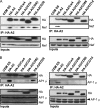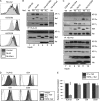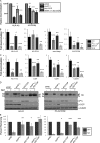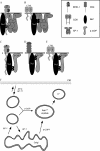HIV-1 Nef disrupts intracellular trafficking of major histocompatibility complex class I, CD4, CD8, and CD28 by distinct pathways that share common elements
- PMID: 21543478
- PMCID: PMC3126561
- DOI: 10.1128/JVI.00229-11
HIV-1 Nef disrupts intracellular trafficking of major histocompatibility complex class I, CD4, CD8, and CD28 by distinct pathways that share common elements
Abstract
The Nef protein is an important HIV virulence factor that promotes the degradation of host proteins to augment virus production and facilitate immune evasion. The best-characterized targets of Nef are major histocompatibility complex class I (MHC-I) and CD4, but Nef also has been reported to target several other proteins, including CD8β, CD28, CD80, CD86, and CD1d. To compare and contrast the effects of Nef on each protein, we constructed a panel of chimeric proteins in which the extracellular and transmembrane regions of the MHC-I allele HLA-A2 were fused to the cytoplasmic tails of CD4, CD28, CD8β, CD80, CD86, and CD1d. We found that Nef coprecipitated with and disrupted the expression of molecules with cytoplasmic tails from MHC-I HLA-A2, CD4, CD8β, and CD28, but Nef did not bind to or alter the expression of molecules with cytoplasmic tails from CD80, CD86, and CD1d. In addition, we used short interfering RNA (siRNA) knockdown and coprecipitation experiments to implicate AP-1 as a cellular cofactor for Nef in the downmodulation of both CD28 and CD8β. The interaction with AP-1 required for CD28 and CD8β differed from the AP-1 interaction required for MHC-I downmodulation in that it was mediated through the dileucine motif within Nef (LL(164,165)AA) and did not require the tyrosine binding pocket of the AP-1 μ subunit. In addition, we demonstrate a requirement for β-COP as a cellular cofactor for Nef that was necessary for the degradation of targeted molecules HLA-A2, CD4, and CD8. These studies provide important new information on the similarities and differences with which Nef affects intracellular trafficking and help focus future research on the best potential pharmaceutical targets.
Figures










Similar articles
-
Direct binding of human immunodeficiency virus type 1 Nef to the major histocompatibility complex class I (MHC-I) cytoplasmic tail disrupts MHC-I trafficking.J Virol. 2002 Dec;76(23):12173-84. doi: 10.1128/jvi.76.23.12173-12184.2002. J Virol. 2002. PMID: 12414957 Free PMC article.
-
The tyrosine binding pocket in the adaptor protein 1 (AP-1) mu1 subunit is necessary for Nef to recruit AP-1 to the major histocompatibility complex class I cytoplasmic tail.J Biol Chem. 2008 Feb 8;283(6):3011-3022. doi: 10.1074/jbc.M707760200. Epub 2007 Dec 11. J Biol Chem. 2008. PMID: 18073204
-
HIV-1 Nef targets MHC-I and CD4 for degradation via a final common beta-COP-dependent pathway in T cells.PLoS Pathog. 2008 Aug 22;4(8):e1000131. doi: 10.1371/journal.ppat.1000131. PLoS Pathog. 2008. PMID: 18725938 Free PMC article.
-
HIV's evasion of the cellular immune response.Immunol Rev. 1999 Apr;168:65-74. doi: 10.1111/j.1600-065x.1999.tb01283.x. Immunol Rev. 1999. PMID: 10399065 Review.
-
HIV-1 Nef: a master manipulator of the membrane trafficking machinery mediating immune evasion.Biochim Biophys Acta. 2015 Apr;1850(4):733-41. doi: 10.1016/j.bbagen.2015.01.003. Epub 2015 Jan 10. Biochim Biophys Acta. 2015. PMID: 25585010 Review.
Cited by
-
The ABCA1 domain responsible for interaction with HIV-1 Nef is conformational and not linear.Biochem Biophys Res Commun. 2014 Jan 31;444(1):19-23. doi: 10.1016/j.bbrc.2013.12.141. Epub 2014 Jan 7. Biochem Biophys Res Commun. 2014. PMID: 24406162 Free PMC article.
-
HIV-1 protein Nef inhibits activity of ATP-binding cassette transporter A1 by targeting endoplasmic reticulum chaperone calnexin.J Biol Chem. 2014 Oct 17;289(42):28870-84. doi: 10.1074/jbc.M114.583591. Epub 2014 Aug 28. J Biol Chem. 2014. PMID: 25170080 Free PMC article.
-
Mechanisms of Immune Evasion in HIV-1: The Role of Virus-Host Protein Interactions.Curr Issues Mol Biol. 2025 May 16;47(5):367. doi: 10.3390/cimb47050367. Curr Issues Mol Biol. 2025. PMID: 40699766 Free PMC article. Review.
-
Concanamycin A counteracts HIV-1 Nef to enhance immune clearance of infected primary cells by cytotoxic T lymphocytes.Proc Natl Acad Sci U S A. 2020 Sep 22;117(38):23835-23846. doi: 10.1073/pnas.2008615117. Epub 2020 Sep 8. Proc Natl Acad Sci U S A. 2020. PMID: 32900948 Free PMC article.
-
HIV-1 accessory proteins adapt cellular adaptors to facilitate immune evasion.PLoS Pathog. 2014 Jan;10(1):e1003851. doi: 10.1371/journal.ppat.1003851. Epub 2014 Jan 23. PLoS Pathog. 2014. PMID: 24465204 Free PMC article. Review. No abstract available.
References
-
- Arold S. T., Baur A. S. 2001. Dynamic Nef and Nef dynamics: how structure could explain the complex activities of this small HIV protein. Trends Biochem. Sci. 26:356–363 - PubMed
-
- Benichou S., et al. 1994. Physical interaction of the HIV-1 Nef protein wih β-cop, a component of non-clathrin coated vesicles essential for membrane traffic. J. Biol. Chem. 269:30073–30076 - PubMed
Publication types
MeSH terms
Substances
Grants and funding
LinkOut - more resources
Full Text Sources
Research Materials

